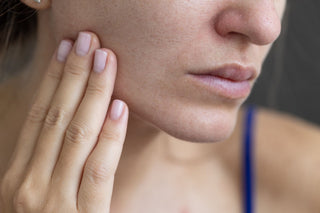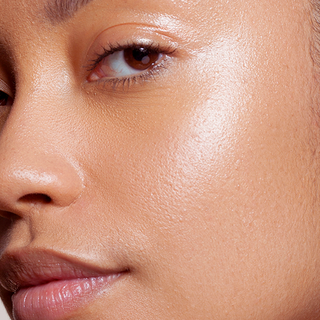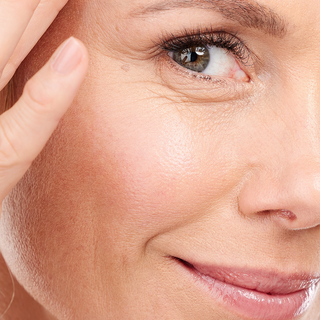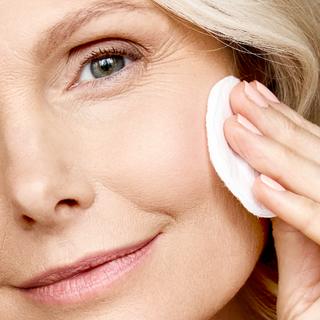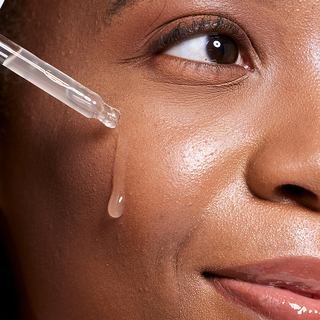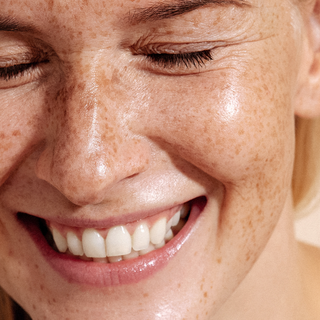If you’ve ever paused at the word “alcohol” on a skincare label, you’re not the only one.
It’s a term that often sparks concern about dryness and irritation, but here’s the truth: not all alcohols behave the same way on your skin.
Cetearyl alcohol, despite its name, is a moisture-boosting multitasker. In fact, it’s used in some of the most effective formulas designed to hydrate, protect, and smooth. Let’s break down what this ingredient actually is, how it works, and why it might be the missing piece in your routine.
Does Cetearyl Alcohol Dry Out Skin?
If the word “alcohol” on a skincare label makes you cringe, you’re not wrong to pause, but you might be misled. Not all alcohols are drying.
Unlike ethanol or isopropyl alcohol, cetearyl alcohol is a fatty alcohol that hydrates, softens, and supports the skin barrier.
Made from a blend of cetyl and stearyl alcohol, this ingredient can be plant-derived or lab-created. Its long-chain structure helps it stay on the skin, locking in moisture rather than evaporating away.
In skincare, cetearyl alcohol wears multiple hats:
-
Emollient: softens and seals in hydration
-
Emulsifier: keeps creams smooth and stable
-
Texture enhancer: adds richness without residue
You’ll find it in moisturizers, cleansers, sunscreens, even eye creams, because it simply works. When used in well-formulated products, it’s not just safe, it’s a quiet hero for dry, sensitive, and mature skin types.
Also Read: Cetearyl Alcohol For Skin
The Myth: All Alcohols Are Drying
That assumption has caused so many people to avoid otherwise excellent skincare products, and it's all because of that one loaded word: alcohol.
The confusion comes from grouping all alcohols into one harsh, drying category.
In reality, alcohols fall into two very different camps: short-chain and long-chain, and understanding the difference is a game-changer for your skincare routine.
Short-chain alcohols, like ethanol, denatured alcohol (SD alcohol), and isopropyl alcohol, are the culprits behind that tight, stripped feeling some toners and gels leave behind.
They evaporate quickly, making them useful for mattifying or quick-dry products, but they can compromise your skin barrier if overused, especially for those with dry or sensitive skin.
Long-chain alcohols, on the other hand, like cetearyl alcohol, are a completely different story. These are fatty alcohols.
They’re rich, waxy, and moisturizing. Rather than evaporating, they sit on the skin’s surface to trap water in, making them soothing and protective. They don’t dry you out, they do the opposite.
That’s why you’ll find cetearyl alcohol in products made to hydrate and strengthen the skin barrier. It’s even FDA-approved for use in formulas labeled “alcohol-free,” because it doesn’t behave like drying alcohols.
Don’t let the name fool you, it’s how an ingredient functions that counts. And cetearyl alcohol works to soften, protect, and hydrate, not harm.
The Truth About Cetearyl Alcohol And Its Effects
Cetearyl alcohol doesn’t dry out your skin, unless something else in the formula is working against it.
So while the short answer is “rarely,” it’s more accurate to say: “Only in specific, often misunderstood situations.” Let’s break down the factors that really matter:
1. Your Skin Type
If you have sensitive or reactive skin, it’s easy to assume that cetearyl alcohol is the issue just because it appears on the label. But most of the time, irritation isn’t about this single ingredient, it’s about the entire formula.
I’ve seen people react to cleansers labeled “for sensitive skin,” only to discover the culprit wasn’t the cetearyl alcohol at all. It was the synthetic fragrance or a harsh preservative bundled into the mix.
2. The Overall Product Formulation
This is where the industry can get messy. If a product contains fragrance, drying surfactants, or known sensitizers, even the most skin-loving ingredients can get caught in the blame game.
Cetearyl alcohol is often paired with other fatty alcohols and gentle actives to create that silky texture we love, but when it’s mixed with formulas that disrupt the barrier, it might feel like it’s the problem. It’s not.
3. How You Use The Product
Layering and timing matter. If your skin stings or flakes after applying retinol followed by a barrier cream with cetearyl alcohol, the cream isn’t likely the culprit, it’s the retinol at work.
The cream just seals it in, making the reaction more noticeable.
Same with frequency, if you’re applying products too often or not spacing out strong actives properly, you may experience redness, tightness, or a light stinging sensation. But again, this isn’t because cetearyl alcohol is drying, it’s because your skin needs a break or better support.
Why Does My Barrier Cream Burn If It’s Supposed To Soothe?
That burning sensation is usually your skin telling you it’s already compromised. It’s not necessarily the barrier cream’s fault, look at what you applied before it.
If you’ve over-exfoliated or used too many actives, even gentle ingredients like cetearyl alcohol can feel irritating simply because your skin is already inflamed.
Can Cetearyl Alcohol Cause Flaking Or Stinging?
Only in very rare cases, and usually not on its own. If you’re experiencing flaking, take a look at your routine holistically.
Are you over-cleansing? Using exfoliants too often? Combining actives that cancel each other out? These are the real culprits I see time and again.
The bottom line? Cetearyl alcohol doesn’t dry out the skin, it’s often the ingredient trying to save it.
Who Might Want To Be Cautious?
While cetearyl alcohol is well-tolerated by most skin types, there are a few exceptions worth noting.
If you fall into one of the categories below, it doesn’t mean you need to avoid cetearyl alcohol entirely. It just means you’ll want to approach new products with a little extra awareness.
1. Fungal Acne-Prone Skin (Malassezia Sensitivity)
If you deal with fungal acne (Malassezia folliculitis), you know how tricky it can be. Some people react to fatty alcohols like cetearyl alcohol, not because they’re harmful, but because the yeast feeds on certain lipids. It’s not a guaranteed trigger, but always patch test and check the full formula.
2. Compromised Skin Barriers (Eczema, Perioral Dermatitis, Post-Procedure Skin)
If your skin is inflamed, like during eczema, rosacea, or perioral dermatitis flares, even gentle ingredients can sting. It’s rarely cetearyl alcohol causing the issue, but raw skin may react to any rich texture. Start with minimal, fragrance-free care, then reintroduce products once your barrier calms.
3. Unknown Ingredient Sensitivities
If a product has ever left your skin red or itchy and you’re unsure why, patch testing is key. Apply a small amount behind your ear or on your inner arm and wait 24–48 hours. Cetearyl alcohol rarely causes irritation, but this step helps you spot any sensitivities safely.
At the end of the day, it’s not about avoiding ingredients out of fear. It’s about understanding how they work, how your skin responds, and building a routine that supports your skin, without overcomplicating it.
When To Use It In Your Skincare Routine
If you’re wondering where cetearyl alcohol fits into your daily lineup, the good news is, it’s already doing a lot of behind-the-scenes work in products you’re probably using.
This ingredient isn’t the star on the label, but it is the reason your moisturizer glides on like silk, your cleanser doesn’t leave you parched, and your eye cream stays put without feeling greasy.
Here’s how to spot it, and where it belongs in your routine:
Cleansers (Gentle, Non-Stripping)
Cetearyl alcohol is a quiet hero in non-foaming, hydrating cleansers.
In formulas like our Soothing Peptide Cleanser, it plays a small but powerful role in keeping the skin barrier intact during cleansing. If your skin feels soft and balanced after washing, instead of tight or squeaky, it’s probably thanks in part to this fatty alcohol.
Creams And Moisturizers (Seal In Hydration)
In your moisturizer, cetearyl alcohol works as an emollient and stabilizer, helping seal in hydration and support your skin’s lipid barrier.
I use it in our Barrier Replenishing Cream because it partners beautifully with hyaluronic acid and ceramides to deliver long-lasting moisture without heaviness or pore congestion.
Eye Creams (Add Emollience Without Heaviness)
The eye area is delicate and quick to react to heavy or irritating ingredients.
Cetearyl alcohol gives our Dynamic Eye Renewal Cream that plush, cushiony feel without weighing the skin down. It helps retain moisture, something especially important as fine lines start to show.
How to Layer It Correctly
To get the most out of products containing cetearyl alcohol, apply them after your active serums and treatments, but before sunscreen in the morning, or as the final step in your nighttime routine.
This ensures that your skin gets the full benefit of your actives, like vitamin C or retinol, while also locking in hydration with a barrier-supportive finish.
My tip? Think of cetearyl alcohol as a “closer”, not the headliner, but the essential finisher that makes everything else in your routine work better.
Also Read: How To Layer Skincare Products
Our Go-To Maria Kane Formulas with Cetearyl Alcohol
For Maria Kane, cetearyl alcohol is not there to fill space on a label; it’s chosen intentionally for how it supports the skin barrier, enhances product performance, and elevates the entire user experience.
Here’s how we incorporate it into three of our foundational formulas:
Barrier Replenishing Cream
This cream was born out of a need I’ve always seen in clients: skin that was dry, depleted, or recovering from procedures like microneedling, chemical peels, or laser.
It needed more than hydration, it needed reinforcement. That’s where cetearyl alcohol comes in.
In this formula, it functions as an emollient that helps rebuild the skin’s lipid barrier, sealing in moisture while softening rough or inflamed skin. It works synergistically with hyaluronic acid and ceramides to restore balance, reduce transepidermal water loss, and soothe discomfort.
It’s the kind of cream that gives your skin a deep exhale, and it’s a go-to for my Colorado clients dealing with dry air and altitude stress.
Dynamic Eye Renewal Cream
The under-eye area is where we see early signs of fatigue and aging first, and also where clients tend to react if a product is too heavy or fragranced.
This cream was carefully formulated to be gentle enough for sensitive eyes while still delivering real results.
Cetearyl alcohol helps the product retain moisture in the delicate eye area without feeling greasy, allowing peptides and antioxidant-rich actives to absorb effectively.
It hydrates, smooths, and brightens, without irritation. Exactly what your eyes need to look fresh and rested, even when you’re not.
Soothing Peptide Cleanser (With A Touch Of Cetearyl Alcohol)
Cleansers are often the silent saboteur in a routine. If they’re too harsh, they strip the skin before the rest of your products even get a chance to help.
Our Soothing Peptide Cleanser uses a gentle, hydrating base with a hint of cetearyl alcohol to cushion the skin as it cleanses. It removes makeup and impurities without disrupting the skin’s barrier, making it ideal for anyone with dry, reactive, or post-treatment skin.
Cetearyl alcohol’s presence in this formula helps prevent that tight, parched feeling you get from typical cleansers. It’s the subtle but crucial difference between “clean” and “compromised.”
Your Top Questions About Cetearyl Alcohol, Answered
When it comes to skincare, the smallest ingredient can spark the biggest questions, and I love that.
Curiosity is a sign that you care about what you're putting on your skin.
Below are some of the most common concerns I hear in my consultations and from our community, answered with clarity and care.
Q: Can it clog pores or cause breakouts?
A: Cetearyl alcohol is considered non-comedogenic in most well-formulated products. That means it won’t clog pores for the vast majority of users.
If you're acne-prone, the real key is looking at the entire formulation, not just this single ingredient. Heavy oils, synthetic fragrances, or occlusive fillers are more likely culprits when breakouts happen.
Q: Is it safe for my eye area?
A: Yes, when it’s used in a properly balanced formula. That’s why I include it in our Dynamic Eye Renewal Cream. It helps retain moisture and improves glide without causing puffiness or irritation.
The result? A soft-focus finish that’s hydrating, never heavy.
Q: Could it cause burning or irritation?
A: Not on its own. If a product containing cetearyl alcohol stings or causes redness, it’s usually not this ingredient that’s to blame.
More often, it’s fragrance, essential oils, or preservatives in the same product. I always recommend patch testing, especially if your skin is already compromised or you’ve recently used actives like retinol or exfoliants.
Q: Is it better than other moisturizers for dry climates?
A: Absolutely. Living and working in Colorado, I’ve seen what altitude and arid air can do to the skin.
Cetearyl alcohol is a key player in barrier protection, helping to lock in hydration and shield against environmental stressors. That’s exactly why I use it in our Barrier Replenishing Cream, to offer that extra layer of defense in dry, cold conditions.
Is Cetearyl Alcohol Safe To Use On Skin?
✅ Not drying
✅ Supports the skin barrier
✅ Works for most skin types
✅ Trusted in clinical-grade products
After years of treating real skin, dry, oily, sensitive, and post-procedure, I started to develop a deep appreciation for the ingredients that consistently do their job without drama.
Cetearyl alcohol is one of those ingredients. It’s a quiet workhorse that softens, protects, and enhances the effectiveness of everything it touches.
Unless you have a rare sensitivity or are in the middle of a serious barrier flare, this fatty alcohol is not just safe, it’s often exactly what your skin needs. When used intentionally, it hydrates instead of irritates, strengthens rather than strips, and elevates rather than overwhelms.
That’s why Maria Kane trusts it in our most barrier-supportive, recovery-focused formulations.
Ready to Try It? Let Maria Kane Do the Work for You
If you're up for hydration that doesn't just feel good but actually supports your barrier, explore our essentials:
Give your skin the care it deserves, with confidence, clarity, and ingredients that truly work.

